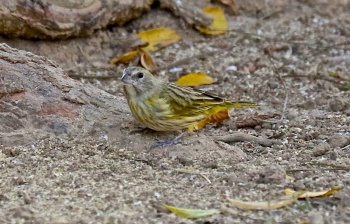m (Amended photo caption typo. Subspecies added to image. Links. References updated) |
m (→Habitat) |
||
| Line 36: | Line 36: | ||
==Habitat== | ==Habitat== | ||
| − | They use a wide variety of habitats, open lowlands with trees and shrubs. Towns, parks, farms. | + | They use a wide variety of habitats, open lowlands with trees and shrubs. Towns, parks, farms. To 2100m. |
==Behaviour== | ==Behaviour== | ||
Revision as of 00:30, 28 March 2019
- Sicalis flaveola
Identification
Length 13·5–15 cm (5¼-6 in)
Male
- Bright yellow overall plumage
- Orange crown
- Black edges to back and flight feathers
- Dark eyes
- Greyish-pink legs
- Greyish-black upper mandible
- Ivory lower mandible
Female: Heavily streaked with edges of primaries and tail yellow.
Immature: Same as female.

Photo by Stanley Jones
South Wild, Pantanal, south of Poconê, Mato Grosso, Brazil, August 2015
Distribution
South America: found from eastern Colombia, Venezuela, Guyana, Ecuador, Peru, Bolivia, north-eastern and south-eastern Brazil, Paraguay, Uruguay, Chile and northern Argentina
This species has been introduced via the cage-bird trade to several other tropical areas (Panama, Puerto Rico, Hawaii, etc.).
Taxonomy
Subspecies
Four subspecies are recognized1:
- S. f. flaveola:
- S. f. valida:
- S. f. brasiliensis:
- Tropical north-eastern Brazil (Maranhão, Minas Gerais and São Paulo)
- S. f. pelzelni:
Some sources also recognize koenigi2.
Habitat
They use a wide variety of habitats, open lowlands with trees and shrubs. Towns, parks, farms. To 2100m.
Behaviour
Diet
Their main diet consists of seeds, with the addition of some arthropods. They feed on the ground, including town gardens.
Breeding
They are cavity nesters. The clutch consists of 3-5 eggs which are incubated by the female alone for 14 days. The young are fed by both parents and fledge at around 2 weeks old.
See also the note under this image: http://www.birdforum.net/gallery/showphoto.php/photo/214292
References
- Clements, J. F., T. S. Schulenberg, M. J. Iliff, D. Roberson, T. A. Fredericks, B. L. Sullivan, and C. L. Wood. 2017. The eBird/Clements checklist of birds of the world: v2017, with updates to August 2017. Downloaded from http://www.birds.cornell.edu/clementschecklist/download/
- Avibase
- Handbook of the Birds of the World Alive (retrieved November 2016)
Recommended Citation
- BirdForum Opus contributors. (2025) Saffron Finch. In: BirdForum, the forum for wild birds and birding. Retrieved 13 May 2025 from https://www.birdforum.net/opus/Saffron_Finch
External Links





